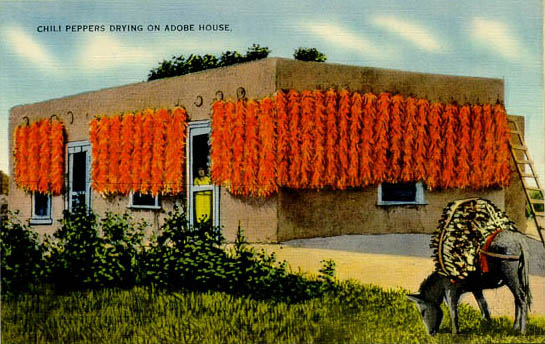To establish a link between capsaicin and endorphins, Etscorn used a drug called naxalone, which can reverse the effects of a heroin overdose by blocking brain receptors that respond to the heroin. In one experiment, he had a student eat the hottest jalapeños he could find until his mouth was burning up and perspiration was pouring off his face. The student was then asked to indicate when the pain began to diminish, and was given at that point a naxalone injection, which caused the pain to increase as the endorphins were blocked from the brain.
Interestingly enough, chile is a substance that most mammals (birds and reptiles seem to be unaffected by its heat properties) will avoid as they would a poison. Through a series of studies, Dr. Rozin found that it is practically impossible to induce a preference for chile peppers in rats, and subsequent experiments with dogs and chimpanzees have had limited success. A study he conducted in 1979 states that humans are the only mammals that “reverse their natural rejection” to bitter “innately unpalatable substances” such as nicotine, coffee, alcohol, tobacco…and chile peppers. They can learn to prefer the flavor and physiological effects of these ingredients to the point of choosing to eat them regularly.
In the case of chile peppers, one reason for reversing this preference might be practicality. A 1980 Rozin study found that the most common reason Mexican people gave for eating chile is that it “adds flavor to food.” It also observed that chile might be a digestive aid: “With a mealy and bland starch-base diet, typical of the areas where chili pepper is commonly eaten, chili aids in the ingestion and swallowing of food and may enhance the palatability of food.”
But why do we choose to eat chile in the first place? It does not create physical need, and babies and young children reject it, as do adults who have never tried it. The only animals Rozin found during the course of his studies who exhibited true, laboratory-proven preference for chile, were two chimpanzees and a dog, all of which had strong relationships with humans.
 And therein lies the key–socialization. Young people develop a taste for cigarettes, coffee, and alcohol by repeatedly using these substances because they want to be included and identified with a certain group, either family or peers. This is also the case with chile, stated a Rozin study. “No explicit rewards are given for eating chili in the home,” it said. “There is, however, the possible more subtle reward for being adult and doing what members of one’s society do, as well as the less subtle encouragement of parents and peers.”
And therein lies the key–socialization. Young people develop a taste for cigarettes, coffee, and alcohol by repeatedly using these substances because they want to be included and identified with a certain group, either family or peers. This is also the case with chile, stated a Rozin study. “No explicit rewards are given for eating chili in the home,” it said. “There is, however, the possible more subtle reward for being adult and doing what members of one’s society do, as well as the less subtle encouragement of parents and peers.”
Another Rozin study asked American college students how they got started eating chile, and the most common response was that they used it at home, or that their parents put it on food. In Mexico, where chile-eating is a part of everyday life, very young children are protected from exposure to it, then allowed to develop their own preference, which usually starts between the ages of four and eleven.
This socialization theory explains possibly why people start eating chile in the first place, but in a non-chile-centered society, the reasons they continue to eat it are less clear. Rozin’s “Benign Masochism” or “Constrained Risk” theory holds that people like chile peppers for the same reasons they like roller coasters, scary movies, and stepping into hot baths. All of these activities provide methods of exciting the body by making it respond to a dangerous situation, while the mind is certain that circumstances are safe. “This body/mind disparity may be a source of feelings of mastery and pleasure, a case of body over mind,” the study said. Additionally, Rozin has found that it is not uncommon for people to like the body’s defensive responses, such as the nose and eye tearing that result from eating hot peppers; and he says that people often eat chile at a heat level close to the highest they can tolerate, which means that liking chile is related to pushing the limits of pain and tolerance.
Having worked in the Fiery Foods Industry for a number of years, we have found that many of the people who like hot foods tend to be a little more outgoing than those who do not. They like traveling, wearing colorful clothing, meeting new people, and trying new things. Perhaps eating chile peppers is the culinary expression of an adventurous spirit and a fun-seeking nature.
Excerpted from The Healing Powers of Peppers, by Dave DeWitt, Melissa T. Stock, and Kellye Hunter (Three Rivers Press, 1998). Available from online used book stores.









